 The Smartest Mixed Breed Dogs
The Smartest Mixed Breed Dogs
Adopting a dog is one of the best things that dog lovers do. Because you do not know the dog’s background or what has happened to him or her, this is a big decision to make. However, there are various benefits of having a mixed breed dog. These dogs are not only charming but also healthier than their purebred counterparts. Purchasing a thoroughly bred dog assures you of the puppy character, exceptional looks, and working qualities. These mixed dog breeds are more than adorable. Not only that, but they are also super smart and intelligent. The list of the smartest mixed breed dogs is quite long. In this post, we look at 8 of the best mixed breed dogs that we believe will be an adorable addition to your family.
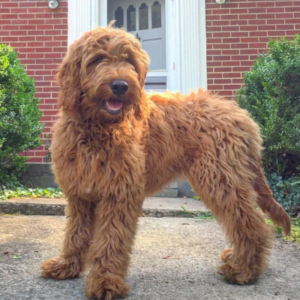 1) Golden doodle
1) Golden doodle
This is a mix of the Golden Retriever and The Standard Poodie dog. The Golden Retriever is believed to be the fourth most intelligent dog of all the breeds. It does well in obedience training, learning tricks, and competitions. The Standard Poodie is the second of all most intelligent dogs. It is smart, resourceful, and very easy to train. When the retriever is mixed with the poodle, a designer breed known as golden doodle is produced.
General appearance: The appearance of this breed varies widely depending on which parent possesses more dominant genes. Their coat can be straight like a Golden retriever or curly like a poodle’s. However, it often lands somewhere in between appearing shaggy or wavy.
Grooming: This breed doesn’t need to be bathed more often than every couple of months unless they get dirty. However, they do require brushing every day to prevent their coats from matting. If their coat is clipped fairly short, they will need brushing once or twice a week. The teeth should be brushed at least twice or thrice a week to remove tartar buildup and bacteria that lurk inside it.
Exercise: The dog requires about 30 minutes of daily play and exercise to remain fit and entertained.
Nutrition: It is recommendable to feed this dog 1 to 4 cups of high-quality dry food every day divided into multiple meals. This depends on the adult size. Keep it in good shape by measuring his food and feeding him twice a day instead of leaving food out all the time.
Health: This breed is generally healthy but like all breeds, is prone to health conditions. Such conditions include ear infections due to the floppy ears, Patellar Luxation whereby the knee joint slides in and out of place, leading to pain, Hip Dysplasia where the thighbone doesn’t fit snugly into the hip joint, and allergies.
Training: This breed is easy to train. He is intelligent and eager to please making it perfect for first-time trainers or experienced trainers. He should be trained with positive reinforcement as harsh conditions can damage his confidence.
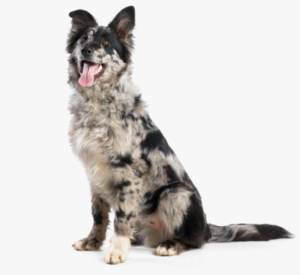 2) Shollie
2) Shollie
This is a cross between the Border Collie dog and the German shepherd. The Border Collie is one of the most intelligent dogs. It typically wins in competitions for a wide variety of skills such as agility, sheepdog trials, and obedience. It can learn up to 50 words. German shepherds on the other hand are used as police dogs as they are super intelligent and are easily trained. They make great guard dogs. The Border collie and German shepherd mix is not only intelligent but also has a good, even temperament as it inherits traits from both breeds.
General appearance: The Shollie is a large dog, weighing up to 80 pounds. It has long, straight legs. It has large ears that are also triangular and may flop over. The eyes are almond-shaped, dark brown.
Grooming: This dog requires to be brushed daily as it is a heavy shedder. Brushing keeps the coat clean and lessens the chances of any mats developing.
Exercise: This dog demands a lot of exercises ideally over an hour a day split up into a couple of sessions to keep it stimulated and satisfied
Nutrition: Shollies need to stick to a healthy diet as overeating can result in weight gain and is associated with health problems. A Shollie diet that is ideal should be formulated for a large dog with high energy.
Health: This breed is generally considered to be a healthy dog. However, it is essential to schedule regular wellness visits to your vet. Shollies suffer from health problems such as elbow dysplasia, Hip dysplasia, and bloat.
Training: The Shollie is easy to train with a committed owner as it is a highly intelligent breed.
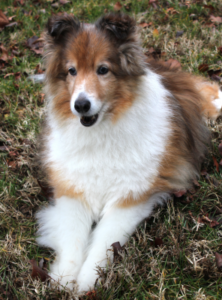 3) Sheltie Heeler
3) Sheltie Heeler
This is a mix between the Shetland sheepdog and the Australian Cattle Dog. Shetland sheepdogs are sixth of all the intelligent dogs. They were bred to herd cattle and sheep using intelligence and concentration. Australian cattle dogs were also bred to herd cattle and are very smart. They are not only resourceful but also intelligent thinkers. A Shetland sheepdog and Australian cattle dog mix is an active breed that requires physical and mental exercise.
General appearance: The dog is medium-sized and has a dense coat.
Grooming: The dog’s coat should be brushed thoroughly weekly. It needs extra brushing during the shedding season. Its teeth should be brushed at least twice or thrice a week to keep them fresh and prevent the buildup of tartar.
Exercise: The dog requires a moderate amount of exercise as it is active and athletic.
Nutrition: The dog should feed on high-quality dog food every day. The recommended quantity s 3/4 to 2 cups divided into two meals.
Health: It is generally healthy. However, the dog is prone to conditions such as Hip Dysplasia, Dermatomyositis, and Collie Eye Anomaly which causes blindness in some dogs.
Training: The dog is easy to train as it is extremely intelligent. However, it can also be stubborn. Ensure that you make training fun and give it time to make up its mind to do what you want it to.
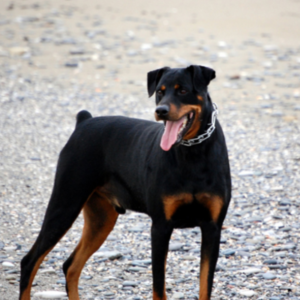 4) Rotterman Dog Breed
4) Rotterman Dog Breed
This is a cross between the Doberman and the Rottweiler. Rottweiler is ninth on the list of intelligent dog breeds. Doberman is intelligent and brave at the same time. They are fifth on the list of the most intelligent dog breeds. They are also dominant and aggressive. When mixed with another breed, they are likely to be calmer. A mix of Doberman and Rottweiler is very intelligent. It is also protective but not aggressive and easily trained.
General appearance: This is a dog that is attractive, elegant, and powerful looking. It is built for speed and endurance. Its body appears almost square and supports legs that are long and elegant. It has a deep chest and a long thin tail. The dog is shiny black with tan highlights on its face, calves, and chest. It has a long and lean muzzle, with teeth meeting in a scissors bite.
Grooming: The dog requires brushing once a week when it is not shedding and daily brushing when in the shedding season. The dog is easy to groom as its coat is naturally glossy and short. The dog requires brushing of the teeth at least twice or thrice a week.
Exercise: The dog requires exercise daily as it is active
Nutrition: The dog should be fed a canine-appropriate diet that will nourish his body and provide the energy required. Ensure that the food has the highest quality ingredients.
Read about the best dog food for Rottweiler.
Health: The dog is susceptible to common health problems just like other dog breeds. It is prone to developing cancer, bloat, heart issues, eye issues, allergies, narcolepsy, hypothyroidism, and panosteitis.
Training: The dog responds well to training as much as they look tough. Training should be delivered in a fun way.
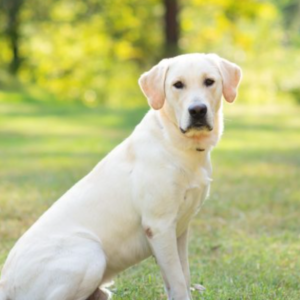 5)Goldador
5)Goldador
This is a mix of the Golden Retriever and Labrador retriever. It is loving, devoted, and energetic. It is also easy to train. Since they are highly energetic, they require plenty of exercise. It makes a good family member as well as a valuable guide, service, and bomb detection dog. It can even make great companions for novice pet parents as it is friendly and affectionate.
General appearance: The dog has a height of 22 to 24 inches and weighs up to 80 pounds. It has a broad head with a defined stop and a strong muzzle. The ears are medium-sized, wide at the base, and hang flat to the head. It has a thick and very strong tail.
Grooming: The dog requires weekly brushing as it sheds moderately. Daily brushing is recommended during seasonal shedding periods. The dog should be bathed as needed. Weekly brushing helps removes dead hair.
Exercise: This is an active dog hence requires at least half an hour of daily exercise
Nutrition: It is recommendable that the dog is fed 3.5 to 4.25 cups of high-quality food every day, divided into two meals.
Health: Goldador is prone to certain health conditions such as Hip Dysplasia, Cataracts that cause difficulty in seeing, and diabetes.
Training: It is easy to train the dog as it is eager to please and extremely intelligent. It is best done through positive reinforcements.
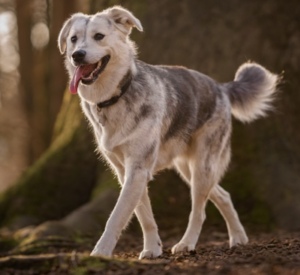 6)Goberian
6)Goberian
Combining two of the most popular dog breeds (Siberian Husky and Golden Retriever) gives you Goberian. It is highly intelligent and very friendly. It is important to note that a hot climate is not ideal for this dog breed due to its double coat. The dog also requires a good amount of exercise daily.
General appearance: The dog commonly has around the head in proportion to his body and ears that hang down. It has a double coat that protects it from extreme weather.
Grooming: The coat of the dog needs minimal maintenance. Brushing him twice or thrice a week keeps his fur healthy and free of debris. The dog should be bathed when needed using a dog shampoo.
Exercise: The dog requires at least an hour of exercise per day to remain healthy and well-behaved since it is very active. This includes walking, hiking, jogging, and playing.
Nutrition: The dog needs to stick to a healthy diet as overeating can lead to weight gain. Choose high-quality canine food that includes natural ingredients. It needs about 2.5 to 3 cups of dry food that is of high quality each day, divided into at least two meals.
Health: The dog is generally healthy but is prone to health conditions such as bloat, epilepsy, Osteochondritis Dissecans, and heart issues.
Training: The dog is moderately easy to train. A consistent and firm approach that is also calm and positive is best as the dog doesn’t respond well to harshness or scolding. Use positive training techniques such as praise, rewards, and treats.
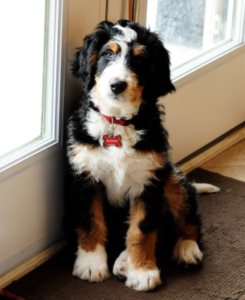 7)Bernedoodle
7)Bernedoodle
This is a mix of the Poodle and Bernese mountain dog. The dog is not only super smart and clever but also calm. Due to that, it is a popular mutt dog among families across the world. The dog also can befriend anyone. It will be cautious among strangers, but in no time, it will be playing with any friendly human. It also has a gentle side making it perfect for both kids and the elderly.
General appearance: The dog has curly, wavy, or straight hair. It has a thick and dense coat with a harsh texture. It has eyes that are oval, dark, and set apart. The ears hang close to their head and have a bushy tail.
Grooming: The dog needs brushing more often to prevent the coat from getting matted.
Exercise: The dog is quite trainable as it is clever. However, it can be stubborn and mischievous. Training is important for it as it prevents the dog from becoming too hyperactive. It should always be done gently with positive reinforcements to get better results.
Nutrition: The appropriate amount of food to feed this dog depends on its size, age, and activity level.
Health: Bernedoodle tends to be healthier than either of the parent. However, it is prone to conditions such as elbow dysplasia, eye problems, skin issues, and hip dysplasia.
Training: The dog is easy to train as it is intelligent.
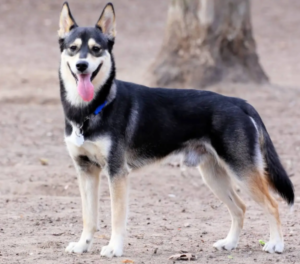 8) Giberian Shepsky
8) Giberian Shepsky
This is a mix of the German shepherd and Husky. It is highly intelligent and can thrive in a variety of roles. The pup has a sturdy frame with lightning-quick agility, making it an excellent police dog or a companion for people with active lifestyles. It is also affectionate, loyal, and sociable. The dog requires a ton of physical and mental stimulation.
General appearance: The dog has startling blue or light golden eyes. It can sometimes have odd-colored eyes, with one being golden brown and the other blue. It is also medium-sized.
Grooming: The dog needs a few brushes per week. The only bath when needed so as not to strip the coat of its natural oils. Brushing helps spread the oil throughout the coat.
Exercise: The dog requires regular and rigorous exercise.
Nutrition: Provide a well-balanced diet so that it remains healthy. Always choose premium kibble that is made from ingredients that are of high quality.
Health: While it is mostly healthy, the kit may be prone to epilepsy, Patellar Luxation, and hip dysplasia. Maintaining good care and regular veterinary checkups are important.
Training: The dog is easy to train as it is highly intelligent and eager to learn.
Benefits of the Smartest Mixed Breed Dogs
- Are often healthier
More gene diversity in mixed dogs means that they are less likely to develop hereditary diseases and disorders.
- They are in style
If you are the kind of person who always has the latest stuff, it is the perfect time to get a mixed breed dog. These dogs also have fancy names such as Labradoodle.
- Cheaper
The initial cost of a dog is very small compared to what will be spent over her lifetime on feeding, vet care among others. Also, it is tough to spend so much money for a pooch when a perfectly good mixed breed dog can be found for a fraction of the price.
- They are full of surprises
Having a mixed breed dog can sometimes be a little scary. However, watching the puppy grow into an individual is also part of the fun of owning a mixed breed. Your mixed-breed dog will become an important part of your family with a lot of love, a little bit of care, and a solid training regimen.
- Unique look
Mixed dog breeds have unique looks. When you combine different breeds, you are unsure about how the genetic will combine. This means that each puppy in a litter can look different from its littermates, and this can result in a very interesting looking litter.
- Can make great pets
Proper socialization and training bring out the best in any behavior and temperament of a dog.
- May become the foundation for a pure breed
Many of today’s purebred dogs were founded on crosses of different breeds. Some of today’s breeds can potentially evolve to be tomorrow’s pure breeds.
- Intelligent
Mixed dog breeds are more intelligent than their purebred counterparts. They perform better in situations that require problem-solving.
Conclusion
If you are thinking of adding a dog to your family, consider adopting a mixed breed dog from a reputable rescue center or shelter. Get one that will fit well with your lifestyle and family. Ensure that it will also fit well with other pets that you already own.
